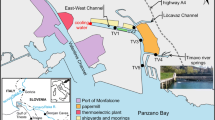Abstract.
The dissolved and particulate trace metals in large and middle-sized Chinese rivers remain comparable with other less-disturbed world systems. Levels of nutrients in Chinese rivers are high due to erosion over the drainage area and the application of chemical fertilizers, which induces an N/P ratio up to 100–1,000. The concentrations of organic pollutants in Chinese rivers are ranked at the lower end of those of world systems; however, pollution has been identified in coastal waters from north to south of the country. In estuarine and coastal waters, dissolved trace metals illustrate a feature of remobilization, while non-conservative distribution is observed, with exceptions for iron and aluminum. Particulate trace metals demonstrate a fairly stable distribution along the salinity gradient, when the absolute concentration is normalized to reference materials. In high-turbidity estuaries, seaward nutrient flux can be increased by a factor of 5–10. Finally, the N/P ratio approaches 10–20 at the interior of the East China Sea, indicating that in coastal regions photosynthesis changes from P to N and Si limitations.
Similar content being viewed by others
Author information
Authors and Affiliations
Additional information
Electronic Publication
Rights and permissions
About this article
Cite this article
Zhang, J. Biogeochemistry of Chinese estuarine and coastal waters: nutrients, trace metals and biomarkers. Reg Environ Change 3, 65–76 (2002). https://doi.org/10.1007/s10113-001-0039-3
Received:
Accepted:
Issue Date:
DOI: https://doi.org/10.1007/s10113-001-0039-3




